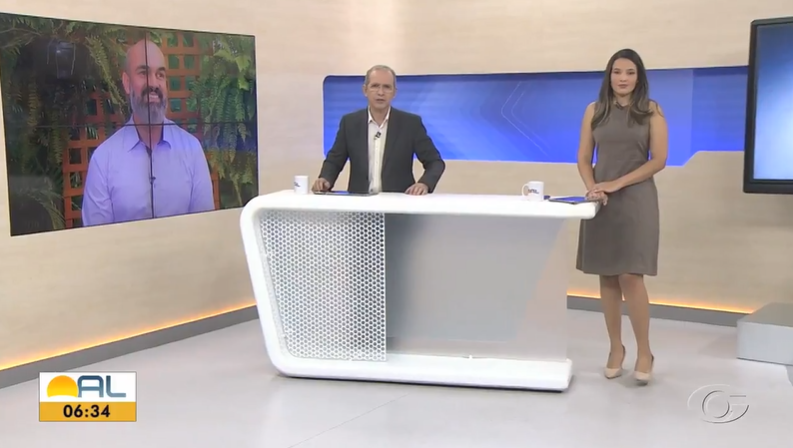
Fraunhofer at Globo

Technological and innovation challenges for 2022
Medicine, telecommunications, agriculture, renewable energies, sustainability. These are all topics that are becoming increasingly important in our daily lives. Solving these societal issues requires the evolution of today's technologies and the integration of many different sectors of society. One example of an institution that has been around for more than 72 years is the German non-profit Fraunhofer Society. It helps society in its evolu-tion by developing technologies in all areas of society. The Director of the Fraunhofer Liaison Office Brazil, Dr.-Ing. Rodrigo Pastl told in an interview for Globo all the innova-tion perspectives for 2022.
Check out the complete interview at: https://t.co/GtAFWl1KVv . Learn more about all the actions in innovation discussed in the interview and get to know a little more about Fraunhofer in the article below.
1 - What does the Fraunhofer Society do?
The Fraunhofer Society, based in Germany, is the world's leading applied research organization. A non-profit organization, its focus is on developing technologies that are vital for the future and enables the commercial exploitation of this work by companies and industry, playing a fundamental and central role in the innovation process.
Today we have almost 30 thousand employees, from all the knowledge of the human being working together in more than 75 institutes, only in Germany, where we had a budget of 2.8 billion Euros in technological development projects.
2 - Which developments Fraunhofer has made that we have in society today and which will be the main challenges we see for the year 2022?
Some examples that we work on that we see in the market today are the White Light LED, airbag triggering system, MP3, MP4, MPEG-H, Augmented Reality Surgeries, Voice Assistant with AI, Industrial Data Spaces, 3D printing of metals, CAR-T cells for Cancer therapy, FIFA's goal identification system, optical filters in the Perseverance robot, which is on Mars, and so on.
For this year of 2022, we are verifying the integration of intelligent systems in medicine, 6G telecommunication technologies, Renewable Energies, Plastic Recycling and also masks (today we have the use of 129 million masks monthly), sustainability, water treatment, in the agriculture area and also in the hydrogen area.
3 - Within these areas, what can you talk about the projects that are in development that can already be seen working?
Well, we have some very interesting technologies. An example is the mask recycling project. 129 million masks are discarded in the world every month. Can you imagine recycling these and putting them back into the medical field and into making new masks? 100% circular economy. Another example is Cognitive Agriculture. We develop technologies to HELP the human being in the field to increase his productivity, reduce the amount of pests and sell with higher quality. All this using the so famous Artificial Intelligence.
Food and packaging technologies coming from Brazilian seaweed. And now also, from Macaúba.
New recycled packaging using organic waste.
Vertical Agriculture: Vertical machines bringing plants with better food quality.
Digital technologies to identify pests in wine grape plantations and thus not lose production.
Automatic and remote mini-plants being accessed via digital platforms to promote agriculture in places of difficult access and low fertilization.
Symbiosis between solar power plants and agriculture, increasing crop productivity: agri-voltaic systems.
4 - How are the international interactions with the Fraunhofer society?
These innovations do not occur overnight or alone. For this to happen it is necessary the involvement of several sectors: industries, governments, universities, research institutes and, of course, society.
All these projects have the involvement of these actors. Small and medium, large companies, federal and state governments of the more than 80 countries where we are working together are highly involved in these innovations.
To get an idea of the impact of these projects, for every 1 Euro in a project within Germany with our institutes, 21 Euros are returned to the German GDP. This is a fantastic lever for any company's business, increasing its revenue by 1.3% and its productivity by up to 0.8%. We help generate more than 340,000 jobs there from 2016 to 2020. Look how fantastic that is. In addition, for the public authorities, for every Euro invested in a project with us, the government receives 4 Euros back in the form of taxes and levies.
In Brazil, we have a very large, long-term partnership with the National Confederation of Industries, helping to develop the Senai Innovation Institutes, and also with the Aeronautics Technological Institute in São José dos Campos, the ITA, and the Food Institute in Campinas, the ITAL.
Innovation comes from the "exchange of figurines" among all actors in society always focused on solving problems, bringing new sustainable solutions, accelerating these technologies in society, generating scientific progress and economic development.
 Fraunhofer Liaison Office Brazil
Fraunhofer Liaison Office Brazil